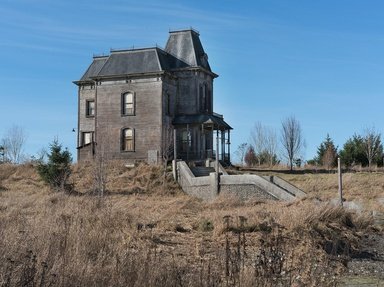Quiz Answer Key and Fun Facts
1. In 1935, this British actor starred as Richard Hannay, a man falsely accused of murdering a woman in his London flat, in Hitchcock's great spy thriller. Four years later, the same actor would beat out the likes of Clark Gable and James Stewart for an Oscar. Who is the actor and what is the 1935 Hitchcock film?
2. For his first American film, Hitch used a respected British actor in the leading role -- the lord of a grand manor who is haunted by his past. The actor wanted his real-life girlfriend to play his character's new bride in this gothic mystery, but Hitchcock cast Joan Fontaine instead. Who is the actor and what is the Hitchcock film?
3. This amiable American actor, who specialized in light comic roles, worked with Hitch twice. The first was in this 1942 saga of a falsely accused man on the run. His quest to clear his name takes him across the USA to a final showdown on a famed New York City landmark. The same actor also played a supporting role for Hitch (in 3-D, no less!) opposite Grace Kelly in the 50s. Who is the actor and what is the 1942 Hitchcock film?
4. Taking a break from his collaborations with Orson Welles, this American actor gave a suitably creepy performance as a psychopathic killer in this thriller set in a small California town. Who was the actor and what is the Hitchcock film?
5. This actor made four films for Hitchcock. The second of the four was this international thriller set largely in South America in the aftermath of World War II. Nazis in hiding and wine bottles figure prominently. Who is the actor and what is the Hitchcock film?
6. This American actor, in the first of four films for Hitch, would step out of character for his role as a cynical intellectual. This adaptation of Patrick Hamilton's stage play tells the tale of two young men, their bizarre murder plot, and a particularly unappetizing dinner party. The action takes place in real time and Hitchcock shot the film in a unique style that reflects this fact. Who is the actor and what is the Hitchcock film?
7. It's tempting to think that, had this actor not died at the age of 32, Hitchcock would have used him again. In the one film that he did make with Hitch, he gave the performance of his life as a psychopathic killer. Hitch stages one of his most horrifying yet beautiful murders in this black and white film, showing us the demise of a young woman in the reflection of her discarded glasses. Crisscross. Who is the actor and what is the Hitchcock film?
8. In this Hitchcock masterpiece of the fifties, a future television star's character is seen almost exclusively through the eyes of the temporarily disabled protagonist -- often through the zoom lens of a camera. We barely even hear the spied upon character speak until the terrifying final moments of the film. Who is the television star-to-be and what is the Hitchcock film?
9. This iconic American actor appeared in only one Hitchcock film. He plays a musician whose life is turned upside down by a false accusation. As he seeks to clear his name, the poor man's wife suffers a mental breakdown. A departure of sorts for Hitch, this is the only film of his that sought to tell a true story. Who is the actor and what is the Hitchcock film?
10. This venerable character actor appeared in more Hitchcock films (six) than any other performer. His roles included a U.S. Senator in "Strangers on a Train" and a psychiatrist in "Spellbound." Most memorably, he played a U.S. government agent with the vague character name, The Professor, in Hitch's great spy thriller. Who is the actor and what is the Hitchcock film?
Source: Author
matriplex
This quiz was reviewed by FunTrivia editor
skunkee before going online.
Any errors found in FunTrivia content are routinely corrected through our feedback system.
